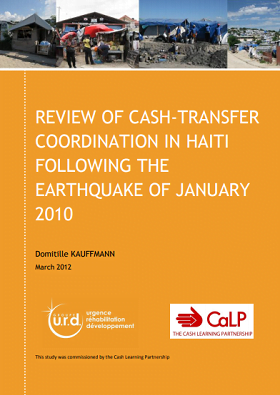Review of Cash-transfer Coordination in Haiti following the Earthquake of January 2010
This study, commissioned by the CALP Network, aims to review and document the coordination of cash transfer programmes (CTP) implemented from the emergency phase in Haiti. It is part of a wider review of CTP coordination in emergency situations which includes three case studies (Pakistan, Haiti and the Horn of Africa, all of which are drawn into a comparative study, which can also be found on the CALP Network website).
The earthquake in Haiti was an example of a large-scale natural disaster in an urban environment where there was little knowledge about CTPs in the country prior to the crisis.
This study identifies success factors contributing to efficient coordination, which include:
– Leadership by NGOs;
– A coordinator with excellent knowledge of the subject and dynamism;
– Organisation of meetings, with relevant themes, in a central location;
– Rapid dissemination of documents and information via email;
– Some visibility provided by the inclusion of the group within the Early Recovery cluster
– Financial support from UNDP (for e.g. studies);
– Longevity of the coordination body.
On the other hand, it is shown that some factors limited the full potential of coordination, including:
– The context (scale of the disaster, lack of leadership from the government, etc.);
– The absence of resources specifically dedicated to the position of coordinator;
– The absence of a clearly identified interlocutor at the governmental level;
– The lack of visibility/recognition of the working group at the level of humanitarian coordination;
– The difficulty of UNDP at the beginning of the crisis to set up the Early Recovery cluster;
– The lack of resources allocated to the CALP Network to support coordination efforts in emergency situations.
The study concludes with recommendations on three different levels:
– Recommendations for the Livelihood Working Groups in Haiti regarding the transition to development, by putting the emphasis on establishing links between key stakeholders.
– Good practice for the setting up and facilitation of CTP coordination in emergency situations (human resources, finance, development of tools, training, and so on), based on experiences in Haiti.
– More strategic reflection about CTP coordination within aid architecture at the global level.
